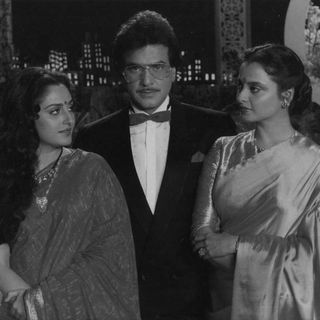Indian Matchmaking is absurd. From the repeated focus on “Hi, I’m Sima from Mumbai” every time the reality show/documentary’s host and all-around horrible person, Sima Taparia, goes to meet a potential client, to the tongue-in-cheek camera work that highlights Bombay client Pradhyuman’s portrait-embossed door handles and fingerprint lock into his walk-in closet. The people of Indian Matchmaking are ridiculous, an idea constantly reinforced by the show’s ironic tone, through background music choice, camera work, and editing. This self-aware mockery is the reason Indian Matchmaking became such a sensation, almost overnight, living in people’s critiques, ironic glorification, and now, in memes.
The show, which follows Mumbai-based matchmaker Taparia as she attempts to find a life partner for a variety of clients — mostly rich Indian people and Indian-Americans living abroad — has been criticized and lauded in equal measure. On the one hand, critics are wondering why Netflix chose to showcase a series that so blatantly holds up the age-old bigotry of Indian society, including colorism, casteism, and classism. On the other, people are happy the show doesn’t politically correct its characters, letting them shine away in their superficial, bigoted glory for all to see.
Throughout it all, Indian Matchmaking paints arranged marriage as a spectacle to marvel at, to laugh at, but never an issue to reckon with. The international show, which essentially functions as a point-look-and-laugh pageant for the Western gaze, also accomplishes another thing in its quest to caricature and, at times exaggerate, Indian arranged marriage processes — it reveals an ideological blind spot in the way many in Indian society have come to think of arranged marriages.
Related on The Swaddle:
Marriage Is an Inherently Unfeminist Institution
It’s easy to ridicule a phenomenon we consider the ‘other’ — for the rich and conservative, or diaspora, only, for the wealthy matchmakers of the world, for the likes of Sima Taparia. And that’s exactly what Indian Matchmaking does — in subtly ridiculing Taparia, it paints everything she stands for as an ‘other,’ in turn legitimizing the show’s more subtle thematic counterpart, the need for love in a lovelorn generation. This dichotomy exists in real life too — if we mock the most absurd parts of arranged marriage, considering it the domain of the wealthy, conservative, or old, it gives us the space to appreciate the irony of a show like Indian Matchmaking. The show portrays Taparia’s constant advice to “compromise,” her accepting her clients’ expectations of a fair, tall, rich partner, and her finding it extremely difficult to match headstrong, successful women, as merely funny, in a this-happens-all-the-time way that is at once ridiculing and normalizing such behavior simultaneously. In doing so, the show redirects focus to why Taparia’s clients sought her network and ‘expertise’ in the first place — either to find love in matchmaking as the last resort, or to appease their controlling, domineering parents, both of which incite a certain kind of sympathy for those involved, automatically foregrounding the role an arranged marriage could play in countering loneliness.
It’s what the modern version of arranged marriages has been lauded as for more than a decade now, one that gives those involved more freedom and agency — to go on dates, to get to know potential partners — supposedly stripping the age-old practice of its oppressive roots. But Indian Matchmaking shows how the distinction we’re so eager to make — between the traditional and the modern arranged marriage — doesn’t really exist. The process is still Brahmanical and casteist; it promotes harmful beauty standards of fair skin and height; and it reduces love and life-long partnership to a transaction, like “ordering things off a menu.” No matter how the process is wielded in modern-day, it cannot escape its roots.




